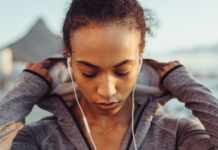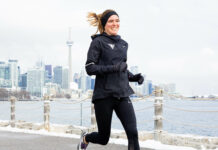
When you mention snowshoes the first thing that many think of are the heavy wooden frames that hang in your grandparents’ house. This Canadian invention has come a long way since its early beginnings.
Snowshoe running is quickly becoming an exciting sport that many runners and triathletes are turning to as their winter pursuit. It’s a great way to keep things fresh and fun during the winter months, while remaining injury free and improving strength.
There are an increasing number of snowshoe races to keep your competitive juices flowing during this typically quieter period.
Newbie snowshoe runners fear that all races are uber-competitive. While many racers are looking to race for place, there are also plenty of participants who are happy to walk or jog the route.
To prepare for snowshoe running, a few strengthening exercises to target specific muscle groups are beneficial. Walking lunges are great to include a few days each week, in addition to some time on an elliptical machine. Both of these best mimic the snowshoe running motion and help to prepare your muscles for the real thing once the snow flies.
To enable you to enjoy snowshoe running to its fullest, a pair of running-specific snowshoes is helpful. Running snowshoes are smaller, lighter and built with a running hinge to allow more energy return and less strain on your body. This will allow you to run more efficiently and akin to your normal running stride.
Regular running clothing will suffice for snowshoe running. Dress in layers to allow for modifications as you warm up or cool down. There may be some snow spray up your back from the snowshoes, so wearing a shell jacket will help to prevent you from getting too wet.
Gore-Tex trail running shoes with gaiters (or built in gaiters) help keep your feet warm and dry, but you can get by with your normal running shoes. Merino wool socks are a wise option when snowshoe running as they still provide warmth, even when wet.
The most important thing to remember on your first snowshoe run is to begin slow and ignore pace, as snowshoe running is always going to be slower than regular running. How much slower depends on the trail and snow conditions. Instead of going by distance and pace, it’s better to go by time and perceived effort (or heart rate). If it normally takes you 30 minutes to run 5K, then just do a 30 minute snowshoe run at the same effort while ignoring pace/distance, to get the same cardio benefit.
Snowshoe running form should be as close as possible to your normal form, with the focus on a relaxed upper body, upright torso and quick stride turnover.
Whether your goal is to compete at a snowshoe race, or you’re just looking at a fun way to enjoy the winter months on the trails, give snowshoe running a try. It’s exhilarating, a great strength-building workout and a wonderful way to enjoy the beautiful trails all winter long!
Race Inspiration 2023
You may also like: Get Snowshoeing!















